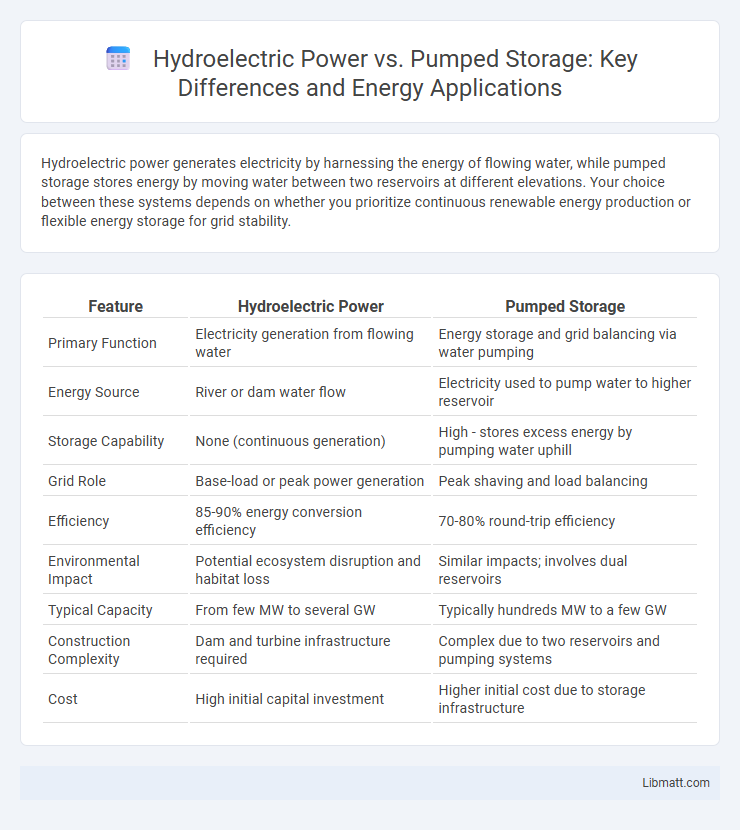Hydroelectric power generates electricity by harnessing the energy of flowing water, while pumped storage stores energy by moving water between two reservoirs at different elevations. Your choice between these systems depends on whether you prioritize continuous renewable energy production or flexible energy storage for grid stability.
Table of Comparison
| Feature | Hydroelectric Power | Pumped Storage |
|---|---|---|
| Primary Function | Electricity generation from flowing water | Energy storage and grid balancing via water pumping |
| Energy Source | River or dam water flow | Electricity used to pump water to higher reservoir |
| Storage Capability | None (continuous generation) | High - stores excess energy by pumping water uphill |
| Grid Role | Base-load or peak power generation | Peak shaving and load balancing |
| Efficiency | 85-90% energy conversion efficiency | 70-80% round-trip efficiency |
| Environmental Impact | Potential ecosystem disruption and habitat loss | Similar impacts; involves dual reservoirs |
| Typical Capacity | From few MW to several GW | Typically hundreds MW to a few GW |
| Construction Complexity | Dam and turbine infrastructure required | Complex due to two reservoirs and pumping systems |
| Cost | High initial capital investment | Higher initial cost due to storage infrastructure |
Introduction to Hydroelectric and Pumped Storage
Hydroelectric power harnesses the energy of flowing or falling water to generate electricity through turbines and generators, providing a renewable and reliable energy source. Pumped storage complements hydroelectric systems by acting as a large-scale energy storage method, using surplus electricity to pump water to an elevated reservoir and releasing it to generate power during peak demand. This synergy enhances grid stability and optimizes energy management by balancing supply and demand efficiently.
How Conventional Hydroelectric Power Works
Conventional hydroelectric power generates electricity by using the kinetic energy of flowing water to spin turbines connected to generators. Water stored in a reservoir is released through penstocks, converting potential energy into mechanical energy as it moves downhill. This process efficiently transforms natural water flow into renewable electricity, providing a consistent power source for your energy needs.
Understanding Pumped Storage Hydroelectricity
Pumped storage hydroelectricity operates by transferring water between two reservoirs at different elevations to store and generate electricity efficiently. During periods of low energy demand, excess electricity is used to pump water to the upper reservoir, while during peak demand, the stored water is released to drive turbines and produce power. This method enhances grid stability and energy storage capacity, making it an essential complement to traditional hydroelectric power plants.
Comparing Energy Efficiency: Hydroelectric vs Pumped Storage
Hydroelectric power plants convert around 35-45% of the potential energy of water into electricity, while pumped storage systems achieve round-trip efficiencies of 70-80%, making them more effective for energy storage and grid balancing. Your decision between hydroelectric and pumped storage depends on whether you prioritize direct electricity generation or flexible energy management during peak demand. Pumped storage enables energy to be stored when demand is low and released when demand is high, optimizing overall grid efficiency.
Environmental Impacts: Pros and Cons
Hydroelectric power generates renewable energy with low greenhouse gas emissions but can disrupt aquatic ecosystems and fish migration due to dam construction. Pumped storage offers flexible energy storage and grid stability, yet it requires large reservoirs that may lead to habitat loss and change in local water quality. Both systems impact land use, with hydroelectric causing permanent landscape changes while pumped storage often involves reversible water level fluctuations.
Grid Reliability and Energy Storage Capabilities
Hydroelectric power plants provide consistent and renewable electricity generation, enhancing grid reliability through stable baseload supply. Pumped storage systems offer superior energy storage capabilities by using off-peak electricity to pump water uphill, which can be released to generate power during peak demand, thus balancing grid fluctuations. Your energy infrastructure benefits from integrating both technologies, combining steady power output with flexible storage to optimize grid stability and operational efficiency.
Cost Considerations and Economic Factors
Hydroelectric power plants typically involve high upfront capital costs due to dam construction and infrastructure, but they benefit from low operating expenses and long lifespans, making them economically viable over time. Pumped storage facilities require significant initial investment as well, but offer added value through energy arbitrage by storing excess electricity during low demand periods and selling it when prices peak, enhancing grid stability. Your choice between these technologies should consider project scale, grid needs, and financial incentives, as cost-effectiveness varies with site-specific factors and market conditions.
Site Selection and Geographical Requirements
Hydroelectric power plants require sites with significant natural water flow and elevation changes, such as river valleys with steep gradients, to harness kinetic energy effectively. Pumped storage facilities demand locations with two reservoirs at different elevations, typically in mountainous or hilly regions, to enable energy storage through water movement between upper and lower basins. Your ideal site selection depends on local topography, water availability, and environmental impact assessments to maximize efficiency and sustainability.
Innovations and Future Trends in Hydroelectric Storage
Innovations in hydroelectric storage emphasize enhanced turbine efficiency, smart grid integration, and advanced materials for longer system lifespan. Future trends include hybrid systems combining pumped storage with renewable energies such as solar and wind for improved grid stability and energy demand management. Emerging technologies like underwater compressed air storage and modular pumped storage plants aim to reduce environmental impact and expand the flexibility of hydroelectric storage solutions.
Conclusion: Choosing the Right Solution
Selecting between hydroelectric and pumped storage power depends on energy storage needs and grid stability requirements. Hydroelectric plants offer reliable, continuous renewable energy generation, while pumped storage excels in energy storage and managing peak demand fluctuations. A tailored approach combining both can enhance energy efficiency and support sustainable power systems.
Hydroelectric vs Pumped Storage Infographic

 libmatt.com
libmatt.com